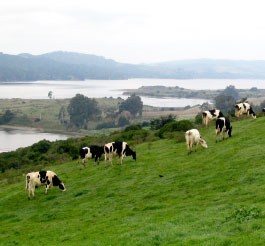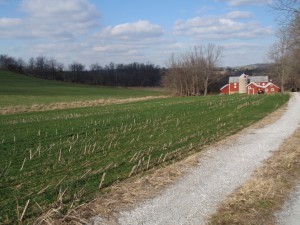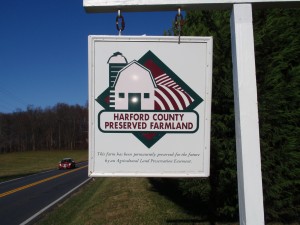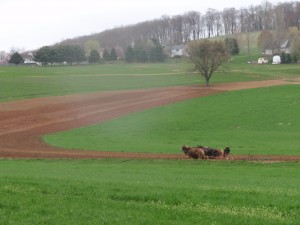Marin overtakes three county programs; Lancaster leads in survey
Click here for 2011 Top 12 County Programs table
A survey of the nation’s locally operated farmland preservation programs shows Marin County, Ca. having gained a large number of preserved acres and moving up from 11th to 8th place in the 12-place ranking conducted by FPR each Fall. It also showed Lancaster County remaining No. 1 in the nation, and Carroll County, Md. having the largest pool of local funding, at $11 million, to purchase development rights. Burlington County, NJ, has $10 million.
All 12 local programs together logged 14,580 acres, 1,404 acres fewer than reported in the last survey. The survey annually covers progress of the nation’s leading locally operated programs from Sept. 15 of the preceding year to Sept. 15 of the current year.
This year’s survey shows the 12 programs have a total of $52.6 million in local funds, which include county and municipal funds, and private support. That compares with $57.5 available last year. The 12 programs together, along with any help from land trusts and other local programs that preserve agricultural land in those localities, have preserved 687,807 acres.
The Marin program, operated by the nonprofit Marin Agricultural Land Trust (MALT), logged 2,290 acres since last Sept., a gain far exceeding the organization’s previous 12-month tally of 375 acres. Marin’s move up pushed Harford and York Counties down one place in the ranking. But Frederick County, Md., which also would have been pushed down by Marin’s climb up the ladder, managed to retain its 10th place ranking by overtaking Harford County, Md.
MALT’s achievement results from two large deals completed this summer. One of those was on the 1,013-acre Thornton Ranch in western Marin County, a 10-year project that began with a big wait: the ranch family could not sell an interest in the property because the owner’s death triggered a 10-year waiting period to avoid the IRS tax penalty from electing the alternative valuation. Funding for the $2.3 million project came from a combination of state, federal and private sources. The USDA Farm and Ranchland Protection Program (FRPP) provided $810,000; the California Department of Conservation Farmland Conservancy Program provided $480,000, and the remaining $1,039,500 came from MALT’s donors and supporters.
The other notable event for MALT this past summer was a $2 million grant from the Lukasfilm Foundation, along with a visit from founder and filmmaker George Lukas. That grant was used to acquire an easement valued at $2.9 million on the historic Corda Ranch, a 1,214-acre property just west of Novato. That purchase, also, was assisted by a $950,000 FRPP grant.
MALT’s move up the ranking was the most notable movement in the chart for the past year. Lancaster County, however, tallied the most acres for the year (see table).
Carroll County holds on to its 4th place position in the ranking, but the program is not on Easy Street despite its nationally renowned Installment Purchase Agreement (IPA) program that jolted the program forward last year with a whopping 4,178 acres tallied, to land its new total at 61,870 acres. Newly elected county commissioners allocated $5.3 million to the program, but the carrot came with a stick: prove the IPA program was really the way to preserve farmland, with interest payments accumulating and committing the county to an annual payout now at $933,000. The commissioners froze the program in early summer and told staff to establish a citizen task force to study the program and its financing. A few of the commissioners also charged the task force with studying term easements and transfer of development rights (TDR) as possible new tools. The task force has met three times and has one more scheduled meeting. Program manager Ralph Robertson said he hopes to hear from the task force that it endorses the IPA program. While Robertson has been operating the county’s Critical Farms Program, he believes the installment program has been a good fit for the county and a benefit for the county’s farm community. Robertson hired FPR publisher Deborah Bowers in July as a fulltime preservation specialist to replace Jeff Everett, who left in April to become easement programs manager for NRCS in Wisconsin. Bowers, who had been project manager for The Manor Conservancy, Inc. in Baltimore County, started Sept. 1.
The innovative IPA arrangement developed by Robertson and Everett offered a highly attractive six percent semi-annual tax-free interest rate in exchange for a discounted offer that equaled 40 percent of fair market value. The calculation upfront showed that landowners participating would receive 88 percent of FMV when combining interest and principal at the end of the 20-year agreement. Robertson said if the IPA program continues, the interest rate would likely be lowered by at least one percentage point due to increasing costs of zero coupon bonds.
Harford County, which also uses the installment purchase approach, was in 9th place last year, and in 8th place the year before, but is now in 11th place following several years of no funding. Dedicated revenue from a local real estate transfer tax, for a number of years, was held out to ensure payment of the interest on installment purchases of easements it has settled since 1993.
This year after accumulating about $3 million over the reserve, the program was restarted and a new round has approved nine farms and 1,200 acres. The funding will cover the upfront cost of $2.8 million for purchasing the STRIP treasury or zero coupon bonds to cover the principal amounts that will be paid at the end of 20 years. In addition the county will commit to paying annual tax free interest likely set at three percent to the program participants, according to program manager Bill Amoss, for a total cost to the county of $5.68 million for the 1,200 acres.
The setback has had its effect on Harford’s progress in farmland preservation. From Sept. 2008 to Sept. 2009 Harford logged 1,735 acres. But from Sept. 2009 to Sept. 2010 the program logged just 82 acres according to the FPR survey published at that time. This Fall’s survey shows a gain for the program of just 175 acres. Meanwhile, Harford’s real estate market has been showing plenty of new homes in the ag zone, spurred by the Base Realignment and Closure (BRAC) Act, as new Aberdeen Proving Ground personnel set up housekeeping in Harford’s attractive rolling hills.
In neighboring York County, elected officials have been tight-lacing their farmland program for the last several years, funding it at just $200,000 or half that. But state funds of about $1.2 million have made offers possible, and FRPP has come through with $855,704 committed currently. “We hope to receive $587,198 additionally from the FRPP program on two more farms submitted in 2011. The FRPP fund stream has become a big part of our program lately,” said program manager Patti McCandless.
In Montgomery County, where a maturing program has given rise to innovation in retiring residual development rights, the county’s most recent move is to retire the development rights left behind by the downzoning that occurred in 1980 as part of creating the county’s renowned transfer of development rights program. The downzoning in the Agricultural Reserve region in the county’s northern tier allowed retention of one building right per 25 acres (1:25) if a property owner did not transfer rights off site at 1:5, a result that has been recognized as less than what preservation goals intended. The new Building Lot Termination program (or BLT), will have its first numbers to report next year, according to program manager John Zawitoski. The BLT is designed to evolve into a TDR program.
“We had seven applicants for the first open purchase period, offering up 13 BLTs. With the funding we had allocated for the first opened purchase period, we were able to tender offers on seven BLTs, covering about 308 acres. The good news is, while we weren’t able to purchase all the BLTs through the public funded program, we have been contacted by developers needing BLTs for specific development projects in qualified BLT receiving areas,” Zawitoski said. “Because these applicants who weren’t able to get funding during the open purchase period met all eligibility requirements for the public program, they are prime candidates for private market BLT sales. We have provided developers the contract information for these landowners and are encouraged to see movement in the direction of privately acquired BLTs.”
Montgomery has kept its dollars where its policies are – keeping the designated Agricultural Reserve rural is an ongoing process that requires housekeeping along the way. The BLT program is the broom that could sweep away potential future dwellings, and $7 million in funding will keep new acres, though fewer in number, coming in. The value is in the payoff at the micro-local level – fewer houses built in a neighborhood with a whole lot of farming going on; additional value will have to await a cumulative effect, something Montgomery County planning commissioners, who have a knack at thinking big and thinking long term, had no trouble putting into a pipeline.
The money for the BLT comes from $2 million in general allocations and $5 million that was allocated specifically for the BLT program. Some county bond money is also available on a competitive basis to the program, Zawitoski said.
The county’s Agricultural Reserve zone consists of 110,000 acres including four town growth centers.
In Lancaster County, the nation’s premier locally driven purchase of development rights program, the Agricultural Preserve Board (APB) now holds 803 easements totaling 69,107 acres, including 28 easements comprising 2,103 acres held jointly with the Lancaster Farmland Trust. The Lancaster Farmland Trust holds an additional 21,173 acres bringing the total preserved farmland tally in Lancaster County as of Sept. 15, the cut off date for the FPR survey, to 90,280. Additional acres have been preserved since that date.
Lancaster County has a model working relationship with the nonprofit LFT. Under a cooperative working agreement formalized more than a decade ago, not only do the two entities collaborate on joint easements, but the county also makes a direct grant to the LFT for easements it will solely hold. Called a challenge grant, and similar to Chester County’s grants to municipalities, Lancaster awarded $1 million grants annually to LFT beginning in 2006. For 2011, however, the amount was cut back to $750,000.
Lancaster County is due for its recertification by the state board, which in Pa. occurs every seven years (every three years in Md.). Staff is reviewing the program for possible adjustments, according to director Matt Knepper, who says there will be “no major changes in the program, just some minor updates for consistency and to make [it] more user-friendly.” Staff continues to keep an eye on the county’s Rural Enterprise guidelines. Developed in compliance with the state Agricultural Area Security Law, the Lancaster County APB allows preserved farms to operate businesses compatible with agriculture. Among those is the production of renewable energy from sources including wind, solar and animal waste with conditions to be met; no-impact farm-based businesses; and bed and breakfast operation and other agri-tourism enterprises. Knepper said he is particularly keeping an eye on the renewable energy production provision in the guidelines and is considering possibly developing a new section to address agritourism/agritainment.
Last year Lancaster County asked the state board to enable the county to charge fees for reviewing subdivision or lot requests on preserved farms, but no action has been taken to date. The APB feels staff time on lot requests justifies charging a fee. The board charges a $50 application fee for a Rural Enterprise request and $200 for reviewing a Rural Enterprise proposal. The Pennsylvania Farmland Preservation Association, an organization comprised of county program administrators, has made approval of fees a priority.
Public – private partnerships for farmland preservation
BY TOM DANIELS, Senior Contributing Editor
Let me start with a proposition: we need all the money and cooperation we can get between governments and the private sector in order to preserve enough farmland to make a difference over the long run. Land trust personnel often like to point out that “we’re not government.” But land trusts would have a hard time existing without Section 501(c)(3) of the federal tax code, which allows for tax-exempt non-profit organizations and enables land trusts to accept tax-deductible donations of cash, securities, and land. In addition, Treasury Regulations 170(h) allow income tax deductions (and potentially estate tax deductions) for the donation of land and conservation easements. In other words, land trusts are an example of a public-private partnership.
For years, local, state, and federal government agencies have worked with land trusts on joint easement deals. These partnerships, both ad hoc and more formal, have been essential for increasing available financial and staff capacity necessary to get important preservation deals done. An interesting variation of these partnerships is when a local government donates an easement on government-owned land to a land trust to make sure that public land will not be developed at some future date by elected officials who lack a conservation ethic! But more important is how public-private partnerships are succeeding. FPR’s 2011 tally of the top counties in farmland acres preserved shows that the public sector and private sector are both important players in almost every county. In Lancaster County, PA, where I live, the county’s farmland preservation program has preserved over 65,000 acres and the non-profit Lancaster Farmland Trust has preserved more than 23,000 acres.
Private landowners enter into a form of public-private partnership when they sell or donate an easement to a government agency. These landowners are, in effect, relinquishing a part interest in the land to the government. In turn, the government agency is assuming a long-term commitment to monitor and enforce the terms of the easement. The tricky part in this relationship is what happens when the people who sold or donated the easement are no longer living or have sold the land. Second- and third-generation landowners often do not recognize the public-private partnership that exists. This means that a lot of face-to-face conversation, education, and even negotiation may be needed to maintain the partnership on respectful terms. Avoiding conflicts, legal action, and simple misunderstandings are all-important.
Finally, I want to offer the observation that the general public likes to see government and the private sector working together in public-private partnerships. The public is much more likely to support bond measures for land preservation that have the support of the private sector, and to elect public officials who support public-private partnerships for land preservation.
Walmart’s new regional food focus is opportunity for growers
BY BOB HEUER, Contributing Editor
Editor’s Note: The story below by contributing editor Bob Heuer outlines a new regional food sourcing and distribution strategy underway at Walmart, published online in Independent Banker. Heuer, who lives in Evanston, Il., feels farmland preservation as practiced in the East is a temporary phenomenon, and that profitability and production focused on supplying food to urban centers will better sustain agriculture in urbanizing regions. Heuer told FPR, “the demand for local food creates a comparative advantage for farmers near population centers and, thus, a strong economic rationale for public policies to help stabilize urban edge farm economies. Think market forces. Wal-Mart is creating a national template for regional-scale food supply chains—the topic of my recent story for Independent Banker Magazine.”
Children’s book author Dave Sargent was nearing retirement a decade ago. He figured to stay busy by growing vegetables in the backyard and selling them to area farmers markets.
Today his vegetable produce company, Sargent Farms International Banker, generates $4 million a year in annual sales. Squash, okra, peppers and tomatoes are sold through various outlets—most notably Walmart. Early on, Sargent supplied a Walmart store near his northwest Arkansas home. The next year, three store managers were customers.
Now his company supplies vegetables to three Walmart distribution centers in Arkansas, Oklahoma and Missouri. Sargent Farms produce is then sold to consumers at hundreds of Walmart stores throughout the Midwest.
Sargent, who lives less than an hour from Walmart’s headquarters, has become a model agricultural entrepreneur for a corporate strategy to diversify their food sourcing. Walmart, the world’s largest grocer, is not alone in fulfilling a rising demand for locally grown food. Other food chains are aggressively seeking vendors like Sargent to shorten the geographic distance between farm and fork.
With this demand comes an opportunity for community banks and their agricultural customers for greater rural economic growth and revitalization. As the farm and food sector begins to undergo a new market design, some community banks may want to consider and promote the agricultural lending and economic development opportunity.
The big picture
The nationwide proliferation of farmers markets—340 in 1970; 6,132 in 2010—reflects growing consumer interest in how food is produced, where and by whom. Demand for direct market-type products has moved into high-volume, wholesale channels like restaurants, grocery stores and institutional food services. Walmart is a retail industry leader in modifying its business to meet demand for food sourced from nearby farms.
In 2008, the Walmart Foundation awarded the University of Arkansas a $549,000 grant to convene national stakeholders interested in creating a sustainable food system that links small producers with large markets. This “Agile Agriculture” program—facilitated by the Applied Sustainability Center at the Sam Walton School of Business—explored how to create regional-scale supply chains that ensure profitability for producers and distributors, while enhancing local economies and delivering healthy products to consumers.
Two key obstacles impede market growth. Few small producers have the necessary insurance, product traceability and documented food safety systems required to meet the procurement standards of large distributors. In addition, smaller producers often lack access to aggregation facilities that can provide the scale of product volume needed by larger markets.
These findings mirrored Walmart’s activities in the field. Wholesale buyers seek relationships with farmers who can pick, clean, pack and drive their produce to one of the company’s 42 distribution centers within 24 hours. In 2010, Walmart officials reported that regional produce sourcing accounted for 4 percent of sales. The retailer’s goal is to double that number before 2016.
This year, Walmart is targeting three clusters for growing this model—the I-95 corridor in the Mid-Atlantic states, the upper Midwest and the Delta Region along the Gulf Coast.
Multiplier effect
Sargent Farms is putting dollars in a lot of local pockets through a business that generates a constant supply of produce for 20 weeks. Vegetables are grown on 400 acres with the help of eight tenant farmers and as many as 60 employees at the height of harvest season. Most of that land used to be in pasture.
“Cattle ranchers gross about $800 an acre, but I can gross $10,000 an acre raising vegetables,” Sargent figures. “The people I employ live in the area. So do the truckers who move our product.”
The nearest national chain hardware store is a 15-mile drive away. Sargent prefers to patronize his cousin’s hardware store located five minutes from the farm. Another cousin owns the tractor supply store. “It’s great to keep our dollars circulating in the local economy, helping small businesses and generating tax revenues for our town, our schools, county and state.”
Sargent takes pride in running a high-tech operation. “We’re very inventive and are always trying to modify equipment to better fit our needs,” he says, citing a permanent irrigation system as an example of where he reduces expenses. “I haven’t had to raise prices in six years.”
Sargent reports plenty of interaction with Walmart’s regional-produce-sourcing leadership. “Walmart realizes that better produce comes from smaller units of production. The bigger you get, you lose control. If I had 3,000 acres of vegetable production, I wouldn’t be that concerned about 100 acres not meeting specs because that loss would be only three percent of my crop.”
Community banks should look favorably on this type of locally centered agricultural production, Sargent says. “Vegetable growing is not a high-risk business for a good farmer. We insure our crops through a federal program for $750 a year. It is labor intensive. You have to be out in the field everyday inspecting the crops.”
Creating new value
Berni Kurz is a frequent visitor to the Sargent Farms. As staff chair for the Washington County Extension office, he supervises a team of employees who provide technical assistance for area farmers and gardeners.
“In 1991, I started a 13-year period working for Extension in neighboring Crawford County,” Kurz recalls. “At the time, the agricultural economy was quite diverse with almost every type of vegetable grown. … By the time I left to come here to Washington County, there were zero acres of commercially grown vegetables. Low transportation costs had made it cheaper to grow vegetables elsewhere. Now it’s local production that lowers transportation costs.”
Kurz works in Fayetteville—home to the University of Arkansas and a thriving Saturday morning farmers market that has become a tourist destination. Vendors there must produce their own food from one of four contiguous counties. He’s acquainted with 15 producers who sell their wares at the Fayetteville market, but doesn’t expect them to make the business changes required to sell wholesale.
He anticipates that resurging demand for crops sourced from nearby farms will “put farmers back into business or create another cash flow that they have the option to go to.”



